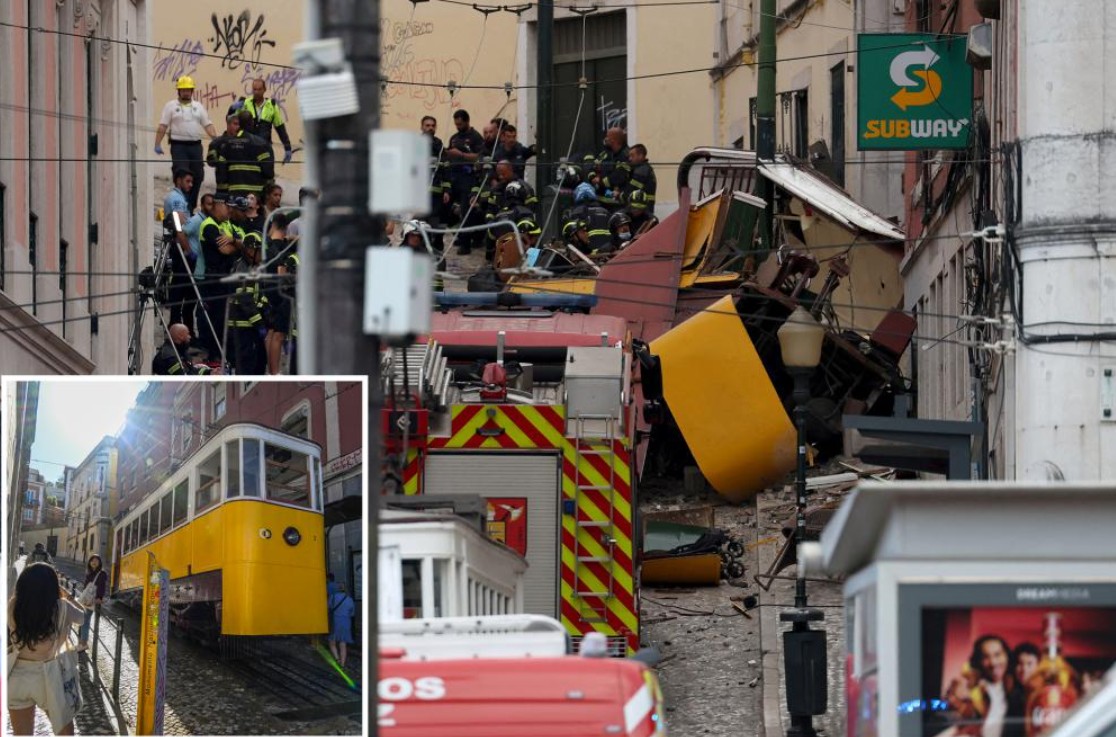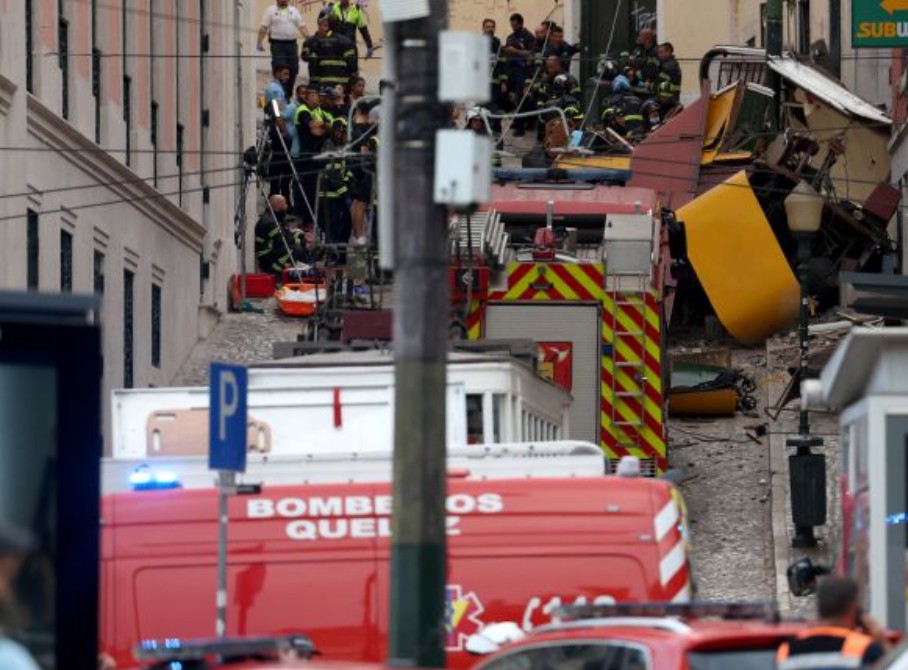Lisbon Funicular Crash Video and Tragedy Strikes
On what was meant to be an ordinary evening in Portugal’s capital, Lisbon, tragedy unfolded in the heart of the city. At least 15 people have lost their lives and 18 more were injured after the famous Gloria funicular derailed and crashed, according to emergency services. The incident has shaken Lisbon, a city where the funicular is not only a practical mode of transportation but also a beloved symbol of its cultural identity.

The Gloria, one of Lisbon’s three iconic funiculars, connects downtown with the vibrant Bairro Alto neighborhood. Designated as a national monument, it has long been a magnet for tourists and a dependable daily ride for locals. But on this day, its familiar charm was replaced by scenes of devastation and despair.
Contents
The Incident and Video
The accident occurred around 6 p.m., during the start of the evening rush hour, when the funicular was carrying dozens of passengers. Eyewitnesses and local media reported that the tram-like vehicle appeared to lose control, careering down the steep hill before derailing. Within seconds, the beloved yellow-and-white carriage lay in ruins.
Video of the accident in Lisbon that shook the world
Footage from the site revealed the extent of the destruction. The funicular, typically known for its sturdy build and slow, methodical climb, was torn apart, with pieces of the carriage scattered across the track. Emergency workers were seen pulling survivors from the wreckage, while others frantically tried to reach those still trapped inside. The sense of urgency and chaos underscored the magnitude of the disaster.
Victims and Casualties
The toll from the accident is devastating. The National Institute for Medical Emergencies confirmed that 15 people died at the scene or shortly after, while 18 others sustained injuries. Among the injured was a child, whose condition remains uncertain, and five other individuals who are in critical condition.

Authorities have so far refrained from releasing the identities or nationalities of the victims. However, officials have acknowledged that some foreign nationals were among those killed. The tragedy thus extends beyond Portugal’s borders, leaving families across different countries grieving and searching for answers.
The UK Foreign Office has already issued a statement, noting that it is in touch with Portuguese authorities and stands ready to provide consular assistance should British nationals be among the victims. Similar responses are expected from other countries as the identities of the deceased and injured are confirmed.
Eyewitness Accounts
Witnesses described scenes of horror and disbelief. According to reports, the funicular began its descent in what seemed to be a controlled manner, but soon picked up speed uncontrollably. Passengers inside were thrown against the walls and windows as the carriage shook violently.
Footage broadcast by CNN Portugal showed the second carriage, which is attached to the same cable system, jolting aggressively when the first derailed. Terrified passengers from the second carriage could be seen leaping out of windows to escape potential disaster. Although this carriage was not physically damaged, the sudden jerks and the shock of the incident left several riders injured and deeply traumatized.
For those on the street, the sound of the crash echoed through the narrow lanes of Lisbon’s historic center. Many rushed to help before emergency services arrived, illustrating the solidarity of locals in the face of tragedy.
The Gloria Funicular: A National Monument
To understand the magnitude of this accident, one must appreciate the symbolic significance of the Gloria funicular. Opened in 1885, the funicular is more than a transport link; it is an enduring piece of Lisbon’s history. Recognized as a national monument, it carries immense cultural and emotional value for residents and visitors alike.
The Gloria runs between the downtown district of Restauradores and Bairro Alto, a neighborhood known for its nightlife, restaurants, and cultural venues. For over a century, it has shuttled residents up and down Lisbon’s steep hills while simultaneously serving as a tourist attraction that offers a glimpse into the city’s charm.
With a capacity of more than 40 passengers per carriage, the funicular is often crowded, particularly during evenings when both tourists and commuters rely on it. That a piece of infrastructure so ingrained in the city’s identity could be the scene of such devastation makes the tragedy all the more painful.
Official Reactions
The scale of the disaster has prompted heartfelt responses from leaders at the local, national, and international levels.
Lisbon’s mayor, Carlos Moedas, announced three days of official mourning for the victims. In an emotional statement, he described the tragedy as unprecedented in the city’s history: “It is a tragedy that has never happened in our city. The moment is for action and help. The only thing I can say is that it is a very tragic day. Lisbon is in mourning.”
Portugal’s President, Marcelo Rebelo de Sousa, also expressed his condolences, offering words of comfort to families and reaffirming national solidarity in the face of such loss.
The European Union Commission president, Ursula von der Leyen, wrote on X (formerly Twitter): “It is with sadness that I learned of the derailment of the famous ‘Elevador da Gloria’. My condolences to the families of the victims.”
Similarly, Portugal’s defence minister, Nuno Melo, described the incident as a national tragedy with international resonance. He extended his solidarity to the victims’ families and wished a swift recovery for the injured.
These messages highlight how deeply the crash has impacted not only Portugal but also Europe and the broader international community.
Company and Maintenance
Attention has naturally turned to the operator of the Gloria funicular, Carris. The company released a statement confirming that scheduled maintenance had been performed on the funicular prior to the crash. Despite these assurances, questions are now being raised about whether the maintenance was sufficient and whether technical failures may have gone unnoticed.
Images from the scene show the carriage in pieces, raising concerns about structural resilience and safety mechanisms. The violent jolt experienced by the second carriage further suggests that the problem may lie in the cable or braking system, though no official cause has been confirmed.
The Investigation
The Portuguese government has announced that an investigation into the cause of the accident will commence once rescue operations are complete. At this stage, several possibilities are being considered, including:
Mechanical failure, particularly involving the haulage cable or braking system.
Human error, whether in operation or oversight.
Broader issues with maintenance protocols and safety checks.
Authorities have promised a transparent inquiry, recognizing that public trust in Lisbon’s transport system and in the preservation of national monuments depends on clear answers. For many, accountability is as important as mourning, ensuring that such a tragedy can never be repeated.
Mourning and Public Impact
As Lisbon enters a period of mourning, the emotional toll of the crash is evident. Families of the victims are grappling with unimaginable grief, while survivors face both physical and psychological scars.
For the city as a whole, the tragedy is a sobering reminder of vulnerability. The Gloria funicular has long symbolized Lisbon’s resilience, history, and ability to blend tradition with modern life. Its derailment is not only a practical disaster but also a symbolic loss, cutting deep into the city’s identity.
Tourists, too, will likely view Lisbon differently in the immediate future. What was once a joyful ride offering panoramic views is now the site of mourning. The incident underscores the importance of safety in heritage transportation systems that, while historic, must meet the demands of modern-day use.
The Gloria funicular crash is a catastrophe that has shaken Lisbon to its core. With 15 dead and 18 injured, including children and foreign nationals, the tragedy has left scars that extend beyond Portugal’s borders. Official mourning, heartfelt condolences, and promises of investigation are only the first steps in a long process of healing and accountability.
For Lisbon, the loss is both human and symbolic. The Gloria was never just a funicular; it was a part of the city’s soul, a living monument of its history. Its derailment leaves behind not only broken steel and shattered glass but also a collective sense of grief and disbelief.
As the city grieves, all eyes now turn to the investigation. The answers it produces will be vital to restoring trust and preventing another tragedy of this scale. Until then, Lisbon mourns, united in sorrow, with the world standing in solidarity.
Daily News -Tyre Nichols Video Sparks Outrage and Justice Calls
Woman Poops on Car in Road Rage Video and Goes Viral
Valeria Marquez Video and Shooting Goes Viral on Social Media
Eugenia Cooney Collapse Video Sparks Global Concern
Daisha Baby Shower Video and Public Outrage
Louisa Jespersen and Maren Ueland Video and Tragic Story
Macron Shove Video Sparks Outrage Over President and Wife

